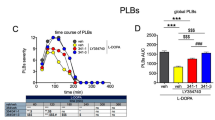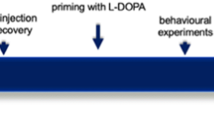Abstract
Common marmosets show parkinsonian motor deficits following 1-methyl-4-phenyl-1,2,3,6-tetrahydropyridine (MPTP) administration and develop dyskinesias during chronic L-dopa exposure. The D1 agonists A-77636 [(1R, 3S) 3-(1’-adamantyl)-1-aminomethyl-3, 4-dihydro-5, 6-dihydroxy-1H-2-benzopyran HCl] and A-86929 [(−)-trans 9, 10-hydroxy-2-propyl-4, 5, 5a, 6, 7, 11b-hexahydro-3-thia-5-azacyclopent-1-ena[c]phenanthrene hydrochloride] possess potent antiparkinsonian activity in the MPTP-treated marmoset and we now assess their influence on L-dopa-induced dyskinesias. MPTP-treated marmosets with stable motor deficits were treated with L-dopa plus carbidopa for 28 days to induce dyskinesias. Subsequently, they received A-86929 for 10 days, initially at 0.5 μmol/kg and then at 1.0 μmol/kg for a further 5 days. Several months later, L-dopa 12.5 mg/kg plus carbidopa 12.5 mg/kg was given orally twice daily for 7 days, followed by A-77636 1 μmol/kg for 10 days, and then both A-77636 and L-dopa plus carbidopa were given concurrently for 3 further days. In these L-dopa-primed animals, A-86929 effectively reversed akinesia and produced dose-dependent dyskinesias which were significantly less intense than those produced by L-dopa administration. A degree of behavioral tolerance was encountered, but antiparkinsonian activity was preserved and elicited behaviour was free of hyperkinesis and stereotypy and more naturalistic than that seen with L-dopa. After a week of twice-daily L-dopa dosing, administration of the long-acting D1 agonist A-77636 initially dramatically enhanced locomotion and reproduced dyskinesia with prominent dystonia, but after repeated administration of A-77636, dyskinesia and in particular chorea, gradually disappeared. Tolerance to locomotor stimulation greater than with A-86929 occurred, although activity remained significantly above baseline levels. There was a marked reduction in L-dopa-induced climbing, stereotypy and hyperkinesis and behaviour more closely resembled that of normal unlesioned marmosets. Upon reintroduction of L-dopa concurrently with continued A-77636 administration, dystonic, but virtually no choreic dyskinesias appeared and behaviour was once again free of stereotypy and hyperkinesis, contrasting dramatically with the presence of these behaviours along with abundant chorea when L-dopa is given alone. These results show a lesser liability of A-86929 and A-77636 to reproduce dyskinesia in L-dopa-primed MPTP-lesioned subjects while maintaining effective antiparkinsonian activity and producing a more naturalistic motor response. The differential effects of A-77636 on chorea and dystonia, with suppression of chorea and stereotypy on co-administration with L-dopa, may reflect an altered balance of activity in the direct and indirect striatofugal pathways. These results suggest a possible role for D1 agonists in the treatment of Parkinson’s disease.
Similar content being viewed by others
Author information
Authors and Affiliations
Additional information
Received: 10 March 1998/Final version: 1 July 1998
Rights and permissions
About this article
Cite this article
Pearce, R., Jackson, M., Britton, D. et al. Actions of the D1 agonists A-77636 and A-86929 on locomotion and dyskinesia in MPTP-treated L-dopa-primed common marmosets. Psychopharmacology 142, 51–60 (1999). https://doi.org/10.1007/s002130050861
Issue Date:
DOI: https://doi.org/10.1007/s002130050861




